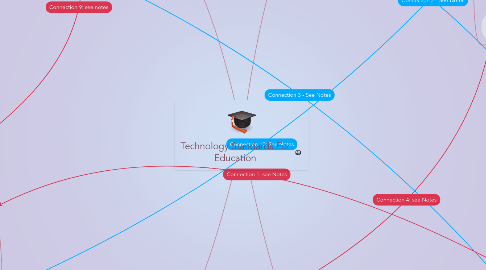
1. ISTE Standards for Teachers
1.1. Facilitate and Inspire Student Learning and Creativity
1.1.1. Teachers will use collaborative knowledge construction by engaging in learning with students, colleagues, and virtual environments.
1.2. Design and Develop Digital Age Learning Experiences and Assesments
1.2.1. Teachers will develop as well as evaluate learning experiences and incorporating contemporary tools and resources to maximize learning of the subject matter and to develop skills listed within the ISTE.
1.3. Model Digital Age Work & Learning
1.3.1. Collaborate with students as well as parents, colleagues, and the digital community on how to using digital tools and resources to support student success within their classroom.
1.4. Promote and Model Digital Citizenship & Responsibility
1.4.1. Teachers should promote and model digital etiquette and responsible social interactions. This can include the discussion of cyber bullying, technological footprints etc.
1.5. Engage in Professional Growth & Leadership
1.5.1. Teachers should engage in Professional Growth and try to continuously improve their professional practice. This is done so by exhibiting lifelong learning and leadership in their school and communities demonstrating the effective use of digital tools/resources.
2. LTPF
2.1. Student Centred Learning
2.1.1. Technology should be used to support student-centred, personalized learning for all students. An example of this would be creating opportunities through play, imagination, reflection, and competition with an entrepreneurial spirit.
2.2. Research & Innovation
2.2.1. Teachers, administrators and other education professionals read, share and apply research and evidence-based practices to advance innovation in educational institutions. For example this can be done by staying current with educational technology research.
2.3. Professional Learning
2.3.1. Teachers, and other education professionals apply the knowledge/skills that allow them to use technology effectively, efficiently in support of learning and teaching. An example of this would be being prepared to use technology and digital resources innovatively and effectively for learning, teaching, leadership and administration
2.4. Leadership
2.4.1. Education leaders establish policy, cultivate innovation and build within the system the ability to leverage technology in support of student-centred learning and system efficiencies. An example of this would be seeking out and participating in partnership opportunities that support innovative use of technology.
2.5. Access, Infrastructure, and Digital Learning Enviornments
2.5.1. All students, teachers, administrators have access to devices, reliable infrastructure, high-speed networks and digital learning environments. An example of this would be ensuring student access to devices, other technologies.
3. ICT Program of Studies
3.1. communicating, inquiring decision making and problem solving
3.1.1. It is important students have the skills to be able to make well thought out decisions, as well as be able to communicate their thought and opinions in the world around them. The ability to problem solve and effectively communicate will be vital in the workplace as well as the world.
3.2. Foundational Operations, Knowledge and Concepts
3.2.1. In order to effecitvely use technology, students must be able to understand the implications and reality of technology in our modern world. By learning the basic of the techonological world such as foundation operations, or concepts, then they have the knowledge to know how to properly and effectively use the tools in a safe and ethical way.
3.3. Process for Productivity
3.3.1. In order to fully utilize tools to their capabilities, students and teachers must know the basics of how individual tools work, as it is impossible to be productive if you don't have the knowledge to use a tool properly.
3.4. How to determine which tools, techniques or process to use and when
3.4.1. Because of the variety of technologies available in our world, students should be able to differentiate between tools/resources and determine which are best suited for a task.
3.5. Impact of Technologies in Student Lives/Workplace
3.5.1. Because of our technologically reliant world, it is often easy to forget the implications that technology can have on our lives. By understanding these implications, students can be more aware of their online presence and existence of a technological footprint. These things we do only can and will affect our lives offline.
4. ISTE Standards for Student
4.1. Empowered Learner
4.1.1. Students will set personal learning goals, develop strategies allowing technology to help in achieving them, then having the ability to reflect on the learning process itself and to improve future outcomes.
4.2. Digital Citizen
4.2.1. Students will engage in positive, safe, legal and ethical behavior when using technology, including social interactions online or when using networked devices.
4.3. Knowledge Constructor
4.3.1. Students will curate information from digital resources using a variety of tools to create collections that demonstrate meaningful connections or conclusions.
4.4. Innovative Designer
4.4.1. Student will have the ability to select and use digital tools to plan and manage a design process that considers design restraints and risks.
4.5. Computational Thinker
4.5.1. Students should be able to formulate problem definitions suited for technology methods such as data analysis, abstract models and in exploring and finding solutions.
